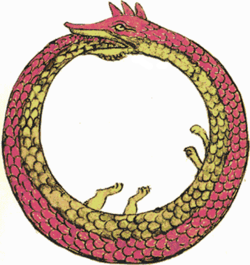This is a Clilstore unit. You can .
Task
- skill of describing, analyzing and interpreting pictures and cultural motifs
- ability of creating new metaphores and justifying them
- using and understanding different idioms with a word time
- awareness of connection between visualisation of time and features of exemplary epoque
- counting the difference between years
- matching famous mathematicians and their historical times
- knowing the units of historical time
Process
Part one, knowledge about culture, english (in english)
1) Analyzing three visions of time. What thay say about it? Try to name (term) the features of time by nouns and adjectives. Look at the pictures, analyze them and try describe that idea of time.
Long time ago, in ancient Egypt and Greece people often visualise Time as a snake or a dragon called Ouroboros. He was eating its own tail. Look at thoe picture, analyze it, and try describe that idea of time.

In the times of Age of Enlightenment (XVIII century) people imagine God as a watchmaker.

Since XIX century popular popculture motif is timetravelling. It apeared first in Charles Dickens and Herbert George Wells books and now it is very imortant in modern science fiction movies.
2) There are many idioms with time. Try to put in pairs correct words and their explanations. You work six in groups. Every group has 5 minutes.
3) Think about your own, original metaphor or visualisation of time.
4) In six groups discuss it, write or draw it down and justify it in front of other studens. We are going to analyze your work with the whole class.
Part two, history (in polish)
Część druga, historia
Już od czasów starożytnych ludzie liczyli czas, wyznaczając punkty graniczne, od których zaczynali odmierzać upływanie dni, godzin czy minut. Dla Greków takim wydarzeniem były pierwsze igrzyska olimpijskie. Rzymianie liczyli czas od założenia Rzymu w 753 r. p.n.e, chrześcijanie od narodzenia Chrystusa. Ten sposób przyjął się w większości państw świata.
Nauczyciel wyjaśnia pojęcia: wiek, era.
Powtarzając wiedzę historyczną, dopasuj wydarzenia do określonych wieków.
Part three, maths
Część trzecia, matematyka
Obejrzyj film i zastosuj zaprezentowaną w nim wiedzę, rozwiązując poniższe ćwiczenia.
Oblicz, ile lat minęło między zaprezentowanymi datami?
Ustaw słynnych matematyków w kolejności - od żyjących najwcześniej do żyjących najpóźniej.
Evaluation
English, knowledge about culture, maths, history
1) Student does not accomplish knowledge and skills specified for 2)
2) Student is describins pictures and connecting some idioms with their meaning, counting the difference between years
3) Student is describing and interpreting picture in basic way and connecting all idioms with their meaning, counting the difference between years, matching famous mathematicians and their historical times
4) Student is describing and interpreting picture in advanced way, connecting all idioms with their meaning, creating own methafor of time, counting the difference between years, matching famous mathematicians and their historical times, knowing the units of historical time
5) Student is describing and interpreting picture in advanced way, connecting all idioms with their meaning, creating own methafor of time and is able to justify it in a clear interesting way, counting the difference between years, matching famous mathematicians and their historical times, knowing the units of historical time
Conclusion
Most important in our lesson is mixing different points of view. Combination of english, math and history content can provide studens chance to see such wide topic as time in a diverse way. At the end of the project studens are asked for reflections after it, answering the question: how this lesson changed your imaginaton of time?
Short url: https://clilstore.eu/cs/5883